Denza sells only one car - electric MPV Denza D9.
The post Average EV prices in March in China: BYD’s Denza first, Li Auto second, Nio fourth appeared first on CarNewsChina.com.
Denza sells only one car - electric MPV Denza D9.
The post Average EV prices in March in China: BYD’s Denza first, Li Auto second, Nio fourth appeared first on CarNewsChina.com.
NIO's battery swap stations now provide over 45,000 services per day. | NIO US | NIO HK | NIO SG

(Image credit: NIO)
NIO (NYSE: NIO) today saw its cumulative battery swap service reach 20 million, with an average of 45,000 services provided daily.
The electric vehicle (EV) maker announced the milestone today on its mobile app, just 273 days, or nine months after it saw its 10 millionth battery swap service on July 4 of last year.
It took the company 1,506 days, or more than four years, to see its first 10 million battery swap services provided.

On February 5, more than 60 percent of the power NIO provides to owners was provided through battery swap stations, and the facility has become a favorite way for NIO customers to replenish their vehicles, it said.
Currently, NIO's battery swap stations provide an average of more than 45,000 services a day, which equates to an average of one NIO vehicle receiving a fully charged battery from these stations every 1.9 seconds.
The 20 million battery swap services can support more than 5,106 million kilometers of driving and reduce carbon emissions by about 550,286 tons, the company said.
NIO's battery swap stations not only provide vehicles with fully charged batteries but also allow owners to easily upgrade their battery packs.
To date, NIO has provided 63,136 battery upgrades to customers, allowing them to continue to enjoy the benefits of battery technology advancements, the company said.

As of today, NIO has 1,327 battery swap stations and 2,442 charging stations in China, according to data monitored by CnEVPost.
The company's goal is to add 1,000 battery swap stations this year, bringing the facility to 2,300 in China by the end of 2023.
The aggressive infrastructure goal is one of the ways to boost sales, and the company's co-founder and president, Qin Lihong, said in a recent interview with local media that the company hopes swap stations will serve partly as showrooms in less developed cities.
On April 1, William Li, founder, chairman and CEO of NIO, reiterated that the company's of battery swap station network is open to other brands and compared the service to cloud services.
NIO's battery swap stations have a good degree of adaptability and the time has come to offer their output to the outside, Li said.
NIO's battery swap network open to other brands, just like cloud service, says William Li
The post NIO reaches 20 million battery swap service milestone appeared first on CnEVPost.
For more articles, please visit CnEVPost.
NIO has nearly completed 20 million battery swap services, with an average of one NIO vehicle leaving a battery swap station with a fully charged battery every 1.9 seconds, said Li. NIO US | NIO HK | NIO SG

The China EV 100 Forum, held in Beijing from March 31 to April 2, brought together some of the biggest names in China's automotive industry.
William Li, founder, chairman and CEO of NIO (NYSE: NIO), spoke at the event on April 1.
Below is the full text of Li's speech, translated and edited by CnEVPost.
Dear chairman Wan, president Qingtai, minister Miao, and distinguished guests, I am very glad to have the opportunity to share some of NIO's latest ideas.
Last year we delivered 122,486 units of high-end smart electric vehicles, which is not a lot compared to our peers, especially compared to BYD.
However, the average price of the vehicles we delivered last year reached RMB 437,000. It can be said that each NIO has witnessed the upward upgrade of China's auto brands.
In the fourth quarter of last year, we had a 54.8 percent market share in the premium EV segment above RMB 300,000 and a 75 percent market share in the premium EV segment above RMB 400,000, and we're doing pretty well in terms of share.
It's true that everyone is facing a lot of difficult choices today, and the uncertainty in the industry is very high.
In our transition from fuel to electric vehicles, what should be the pace of development of the industry? I think we all have a lot of confusion, including myself. These are some of the very difficult choices we are facing.
NIO is a start-up company, and we are not in a position to stop and think too much.
We are determined to invest for the final win while ensuring the risk of our operation is manageable and improving efficiency, which is one of the things we have thought through.
We are investing in three main areas.
First, we are continuing to invest in core technology research and development.
Last year, NIO did lose some money, but I still want to tell you that it was mainly in R&D. However, the money lost on R&D, I think it is an investment.
NIO has been making R&D layouts globally since its creation in 2015. Even in 2019 when the company was about to close, we did not close the office in Europe, we did not close the office in Silicon Valley.
We have now established more than 10 R&D centers in the US, Europe and China.
Our R&D investment in the fourth quarter of last year was close to RMB 4 billion, and our annual R&D investment for the year reached RMB 10.8 billion.
Last year, our annual revenue was nearly RMB 50 billion, so I should say that the proportion of R&D investment is very high.
We will further increase our R&D investment this year, and are now making a comprehensive investment in the full-stack capability of intelligent electric vehicles, including chips, underlying operating systems, materials, and battery cells.
From day one, NIO has never taken anything from anyone else for reverse R&D. We started from a single line to build our cars, electric technology, intelligent technology, and all-aluminum body.
We did all of these ourselves, and this has been our tradition since 2015.
We now have over 10,000 R&D staff and we will still hire close to 2,000 recent college graduates this year and will train them for the long term.
NIO has been granted more than 6,000 patents covering the entire full stack of smart electric vehicle technologies.
We are very pleased to see that we have won the first prizes in the Chinese automotive industry for two consecutive years in 2021 and 2022, and these are the recognition of us.
Not only in China, but also in Europe, our ET7 won the most weighty model award in basically every country we entered last year.
For example, last year we won the most influential "Golden Steering Wheel" in Germany. This is the highest award for mid to large-size cars and the first time that a Chinese brand has won such an award in Germany. We can say that these have witnessed the upward journey of our brand.
Second, one of the directions we have resolutely invested in is the continuous construction of charging and battery swap infrastructure.
Charging and battery swap infrastructure is one of the most important factors determining the user experience of electric vehicles.
When we started research and development in 2015, we set down the service system of chargeable, swappable and upgradable.
In terms of charging piles, we have gone to a lot of trouble in helping users to install more than 180,000 charging piles.
We also installed more than 14,000 public charging piles, and this is open, more than 80 percent of the power is used by non-NIO owners. This includes Tesla, BYD, and many of our peer brand vehicles.
We have access to over a million third-party charging piles globally, and in both China and Europe, we have partnered with the most important local charging pile operators.
We just installed 500 kW ultra-fast charging piles two days ago, which has a bi-directional charging module that we developed ourselves.
This supercharger can in fact reach 650 kW power, and together with our battery swap stations, it can increase the efficiency to a very high level. We are now mainly building integrated stations with both battery swap service and charging piles.
We have deployed 52 destination charging routes in China, such as the route from Sichuan to Tibet and the route to Everest Base Camp.
We will deploy destination charging routes to our customers whenever they want to go, and we will add more than 20 routes this year.
We have already built 1,326 battery swap stations in China, in this picture is the one in Lhasa.
We have also deployed 13 battery swap stations in Europe, and they have been well received in five European countries.
Two days ago we just commissioned our third generation battery swap stations in Hainan, and battery swap has become the most popular way to replenish energy for NIO users.
On February 14, 2022, for the first time, the power provided by our battery swap stations exceeded that provided by charging facilities, and now the ratio has reached 60 percent.
In addition to charging at home, owners are essentially using battery swap stations, and that percentage is much higher than we had anticipated.
We are close to completing 20 million battery swaps, which should be seen in the next two days. On average, every 1.9 seconds an NIO vehicle departs from a battery swap station with a fully charged battery.
Battery swap has many advantages, I won't go into details here.
We have already built a network of battery swap stations covering five vertical highways, three horizontal highways, and eight city clusters.
By 2025, we will have a network of battery swap stations covering 9 vertical highways, 9 horizontal highways, and 19 city clusters, and by then NIO car owners will be able to travel on highways without worry.
Our goal for this year is to add 1,000 battery swap stations, and by the end of this year, we will have 2,300 stations.
We will also add 10,000 new battery swap stations, and in fact, we are the most aggressive car brand in China in deploying battery swap stations.
People always think of battery swap when they think of NIO, but we're actually doing a great job with charging facilities as well.
That's the second point, we will be determined to build the infrastructure.
Third, we will enter the global market with the determination to serve more customers.
On September 30, 2021, we started to deliver in Norway. Many of our Chinese counterparts deliver vehicles in Norway, and we have reached the first and second places in some segments.
On October 7 last year, we officially announced our entry into Europe in Germany, the Netherlands, Denmark and Sweden.
We had a European launch event in Berlin with more than 1,000 guests, which was well received by everyone.
On October 16 last year, we officially started to deliver vehicles in four European countries.
In fact, just two days ago, we just opened our NIO House in Frankfurt, after having opened our NIO House in Berlin and NIO House in Rotterdam.
Overall, this is indeed a particularly challenging time, and NIO has chosen to do the right thing in the long run by making a long-term investment. We believe that this kind of investment will eventually reap good results.
This is also a photo of one of our horizons in the Netherlands, taken by a Dutch photographer, heralding a field of hope.
I believe that the development of smart electric vehicles is a difficult journey, and the road ahead is long and full of obstacles. But if we move forward, we will reach our goal. The future is promising.
I hope we can have a bright future together, thank you.
NIO's battery swap network open to other brands, just like cloud service, says William Li
The post China EV 100 Forum: NIO's William Li's full speech appeared first on CnEVPost.
For more articles, please visit CnEVPost.
NIO's battery swap stations are well adapted and the time has come to offer output to other brands, according to Li. | NIO US | NIO HK | NIO SG
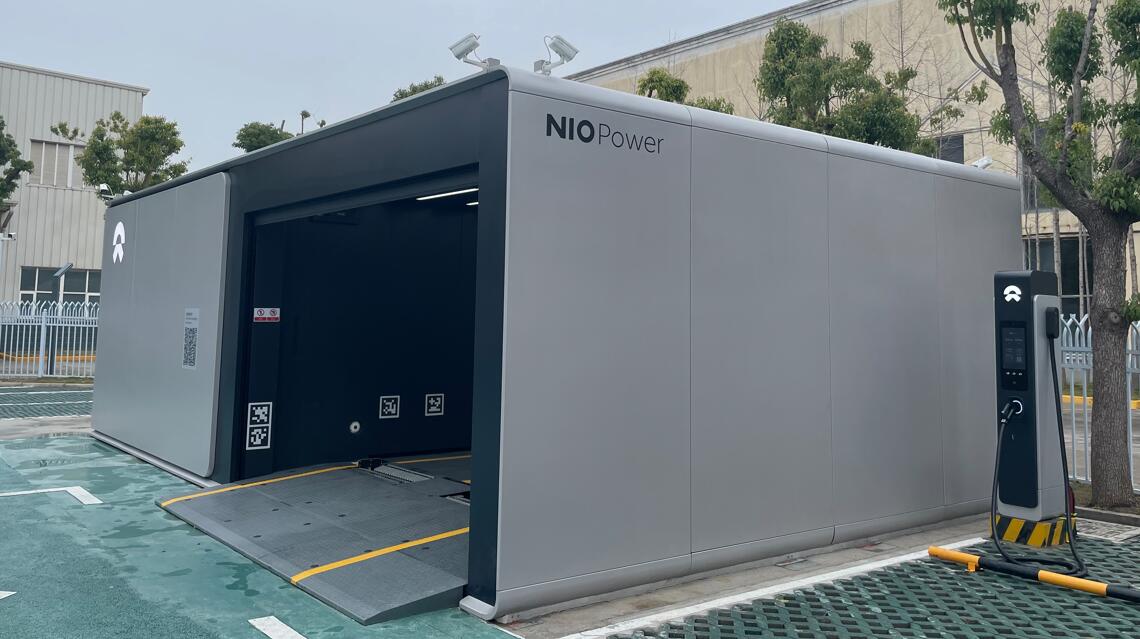
(Image credit: CnEVPost)
The man at the helm of NIO (NYSE: NIO) reiterated that the company's battery swap stations network is open to other brands, and compared the service to a cloud service.
NIO wants other companies to share and build battery swap infrastructure with it, said William Li, the company's founder, chairman and CEO.
Li mentioned this during a media group interview on April 1 during the China EV 100 Forum, saying that there have been discussions between other car companies and NIO on the matter, according to a report today by local media outlet The Paper.
"I met with several company executives today and they asked me how we could work together, and we're open to that," he said.
With 80 percent of the power provided by NIO's charging stations being used by other brands of electric vehicles, it's feasible for the company to offer battery swap services to other car companies, he said, adding that it's just that other automakers would need to design vehicle chassis based on the specifications of NIO's battery packs.
NIO's battery swap stations have a reasonable degree of adaptability, and the time has come to provide output to the outside, Li said.

He said the company calls its battery swap model "battery as a service (BaaS)", an innovation that can be understood through the lens of cloud services.
Cloud services around the world, whether they are offered by Microsoft, Google and Amazon in the United States or Alibaba, Tencent and Huawei in China, they all have one thing in common: The companies themselves are the primary users.
"You certainly can't achieve this kind of service if you're not the biggest user yourself," he said.
On top of being available for their own use, such systems need to be open, and the hardware interfaces, software interfaces, and operational interfaces all need to be complete, said Li.
NIO's battery swap stations are being offered for two generations of vehicle platforms and have supported six models so far, including models from 2018 to 2023.
"I think it's very well adapted and the internal interfaces are very mature," Li said, adding, "We feel that the time has come for it to provide output to the outside world, and we are very willing to explore that with our peers."
It's a bit like Amazon's cloud service, which requires the company to sort out internally the timeline for offering the service externally, he said.
However, Li also noted that, like the time it takes to migrate when using new cloud services, the matter of NIO's battery swap service being available to other brands requires peers to work together to plan ahead before it can be realized in two or three years.
NIO aims for swap stations to serve partly as showrooms in underdeveloped cities
The post NIO's battery swap network open to other brands, just like cloud service, says William Li appeared first on CnEVPost.
For more articles, please visit CnEVPost.
NIO will showcase six models based on the latest NT 2.0 platform at the Shanghai auto show, with the all-new ES6 making its debut.

NIO (NYSE: NIO) will have the facelift of its previously popular ES6 SUV unveiled at the Shanghai auto show later this month, marking the first time the company has unveiled a new model at an auto show.
The company will showcase six models based on its latest NT 2.0 platform at the Shanghai auto show, with the all-new ES6 making its debut, it said in a post announcing March delivery figures on its WeChat account.
The upcoming biennial Shanghai auto show will be held from April 18-27, with the press days from April 18-19 and the professional visitors' days from April 20-21, while the general public can visit from April 22-27.
NIO App is currently showcasing eight models, including the ES8, ES6 and EC6 based on the NT 1.0 platform, and the new ES8, ES7, EC7, ET7 and ET5 based on the NT 2.0 platform.
The EC7 and the new ES8 were launched at NIO Day 2022 on December 24, 2022, and deliveries are set to begin in May and June 2023, respectively.
NIO did not provide any further information on the new ES6, but the model has appeared in a regulatory catalog in China in January.
On January 11, the Chinese Ministry of Industry and Information Technology released a list of models that will soon be allowed to be sold in China, and the new NIO ES6 was included.
The new NIO ES6 has a length, width and height of 4,854 mm, 1,995 mm and 1,703 mm, respectively, and a wheelbase of 2,915 mm, according to the model's filing page.
The model's LiDAR and camera setup are in line with the other current NIO models based on the NT 2.0 platform. Its rear end also features a through-tail lamp design similar to the ET7, rather than the split design of the current model.
The new ES6 is something to look forward to, as its predecessor was NIO's cheapest SUV, contributing the most sales for the company in a very long time.
From January to August 2022, the ES6 delivered 32,877 units, contributing 46 percent of NIO's total deliveries of 71,556 units during that period, figures monitored by CnEVPost from the company as well as the China Passenger Car Association (CPCA) show.
The post NIO's new ES6 to debut at Shanghai auto show later this month appeared first on CnEVPost.
For more articles, please visit CnEVPost.
NIO delivered 31,041 vehicles in the first quarter, slightly above the lower end of its previous guidance range of 31,000 to 33,000 vehicles. | NIO US | NIO HK | NIO SG

NIO (NYSE: NIO) delivered fewer vehicles in March than in February, with the first quarter figure barely above the lower end of the previous guidance range.
NIO delivered 10,378 vehicles in March, up 3.94 percent from 9,985 a year ago but down 14.6 percent from 12,157 in February, according to figures it announced today.
That delivery volume included 3,203 SUVs, and 7,175 sedans, the company said, without providing a breakdown of the different models.
NIO delivered 31,041 vehicles in the first quarter, slightly above the lower end of its previous guidance range of 31,000 to 33,000 vehicles.
The deliveries were up 20.46 percent from 25,768 units in the same period last year, though down 22.5 percent from 40,052 in the fourth quarter.

NIO's guidance for first-quarter revenue was RMB 10.93 billion to RMB 11.54 billion when it announced its fourth-quarter earnings results on March 1.
As of March 31, cumulative deliveries of NIO vehicles reached 320,597 units.
Beginning March 28, NIO has rolled out the deployment of its third generation of swap stations in China, each with a service capacity of up to 408 swaps per day, the company said.
As of March 31, NIO had deployed 1,339 battery swap stations and 1,285 charging stations, including 6,467 chargers, worldwide. It also has 1,154 destination charging stations worldwide, including 7,993 chargers.
NIO will accelerate the expansion of its battery swap network and plans to install 1,000 battery swap stations in 2023, it said, repeating a previous goal.
NIO has been gradually releasing NOP+ Beta to NIO Technology 2.0 (NT 2.0) based vehicles. Since its debut on December 27, 2022, more than 30,000 users have activated and participated in the NOP+ Beta, accumulating more than 15 million kilometers, it said today.
Powered by NIO's internally developed full-stack smart driving technology and closed-loop data management, NOP+ Beta has achieved significant improvements in peace of mind, comfort and efficiency, it said.
Going forward, NIO will progressively deliver more features through over-the-air updates to continuously enhance the user's smart driving experience, the company said.
The post NIO delivers 10,378 vehicles in Mar, down 14.6% from Feb appeared first on CnEVPost.
For more articles, please visit CnEVPost.
Li also said that Tesla's price cut comes after it faced stiff competition in China, where it does not have pricing power.

(Image credit: CnEVPost)
NIO's (NYSE: NIO) first phone model will be launched and delivered in the third quarter, William Li, the electric vehicle company's founder, chairman and CEO, said today.
Li mentioned the plan in a media group interview today during a forum on China's electric vehicle industry, according to multiple media reports, without providing further details.
Li confirmed in late March last year that NIO would be getting into phone making, saying the company's NIO customers wanted to see a phone that connected better with NIO cars, which prompted the company to look into the industry.
In an internal presentation at the end of November last year, Li said the decision to make the phone was based on long-term strategic thinking over a 5-10 year horizon.
In addition to mentioning a timeline for the launch of the first NIO phone, Li said in an interview with National Business Daily that Tesla doesn't have pricing power in China.
"Tesla's price cut was an action taken after facing stiff competition in the Chinese market, where it doesn't have pricing power," Li said.
Tesla has pricing power in the US market because it has a 60 to 70 percent share in the new energy vehicle (NEV) market there, Li said, adding that in China's NEV market, Tesla has only a 7 percent share.
With 60,766 retail sales in China in January-February, Tesla ranked second in the Chinese NEV market with a 7.8 percent share, according to data released last month by the China Passenger Car Association (CPCA).
BYD retail sales in January-February were 316,417 units, ranking first in China's NEV market with a 40.8 percent share.
NIO sold 20,663 units in the same period, ranking 8th with a 2.7 percent share.
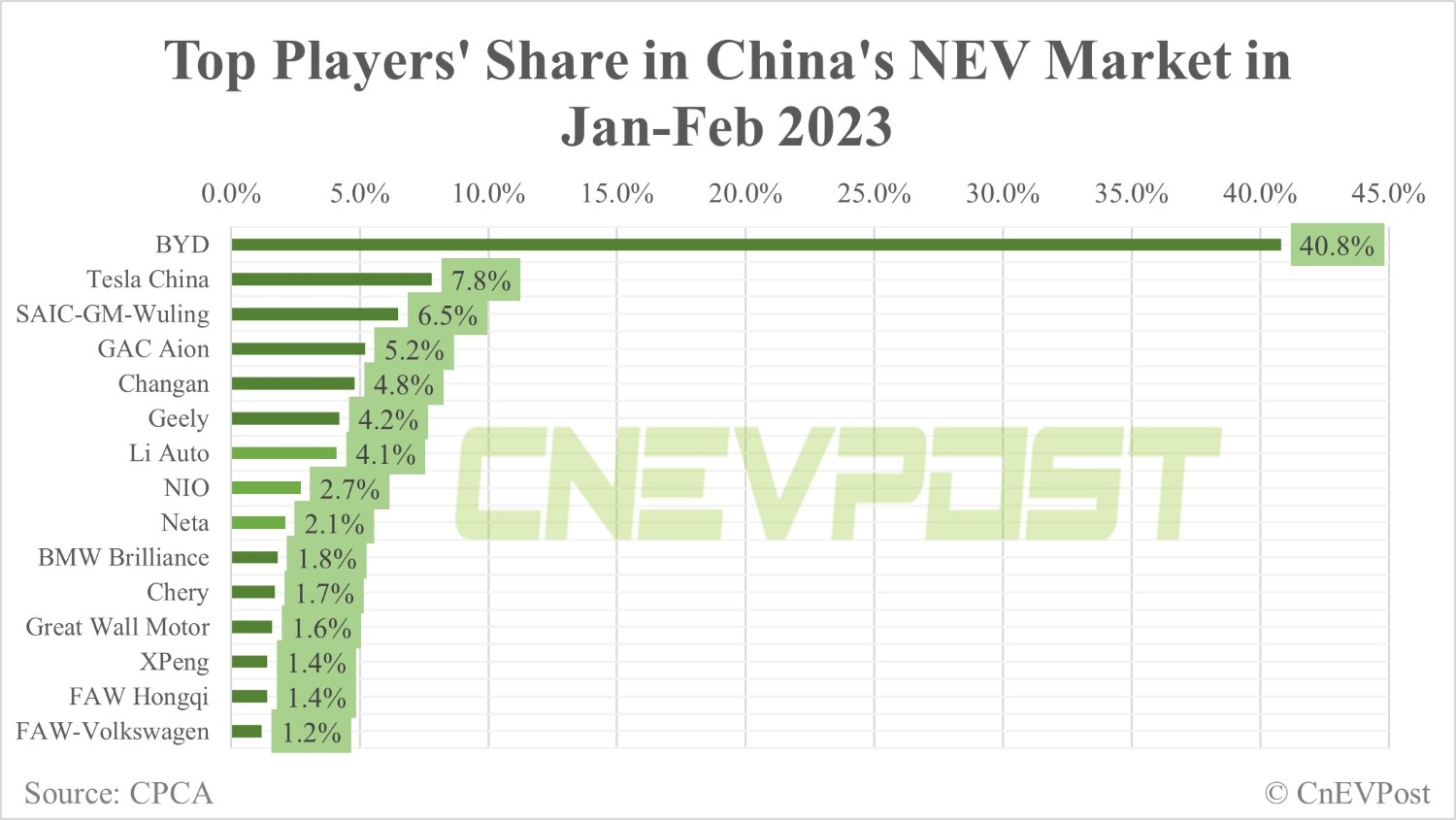
BYD clearly has pricing power, and interestingly, the man at the helm of the NEV giant also mentioned the topic earlier this week.
BYD has pricing power in the price range of RMB 100,000 ($14,560) to RMB 200,000, but the company wants to keep things steady, its chairman and president Wang Chuanfu said at a March 29 investor conference.
BYD doesn't want to make it hard for others to survive, Wang said.
($1 = RMB 6.8690)
The common feature of NIO, Li Auto, XPeng's mobile apps? Pretty girls!
The post NIO's 1st phone model to be launched in Q3, says William Li appeared first on CnEVPost.
For more articles, please visit CnEVPost.
NIO ET7 deliveries in Europe began last October, and EL7 deliveries there began at the end of January. | NIO US | NIO HK | NIO SG

(Image credit: NIO App)
NIO (NYSE: NIO) began ET5 deliveries in Europe on March 31, the day before it opened its second NIO House in Germany.
The company saw the first deliveries of the electric sedan in Germany, Sweden and the Netherlands, according to the information posted on the Chinese and European versions of the NIO App.
NIO co-founder and president Qin Lihong was in Germany to witness the first ET5 deliveries there.
No information has been released about ET5 delivery figures in Europe. The company is expected to announce its deliveries of all vehicles in March later today.
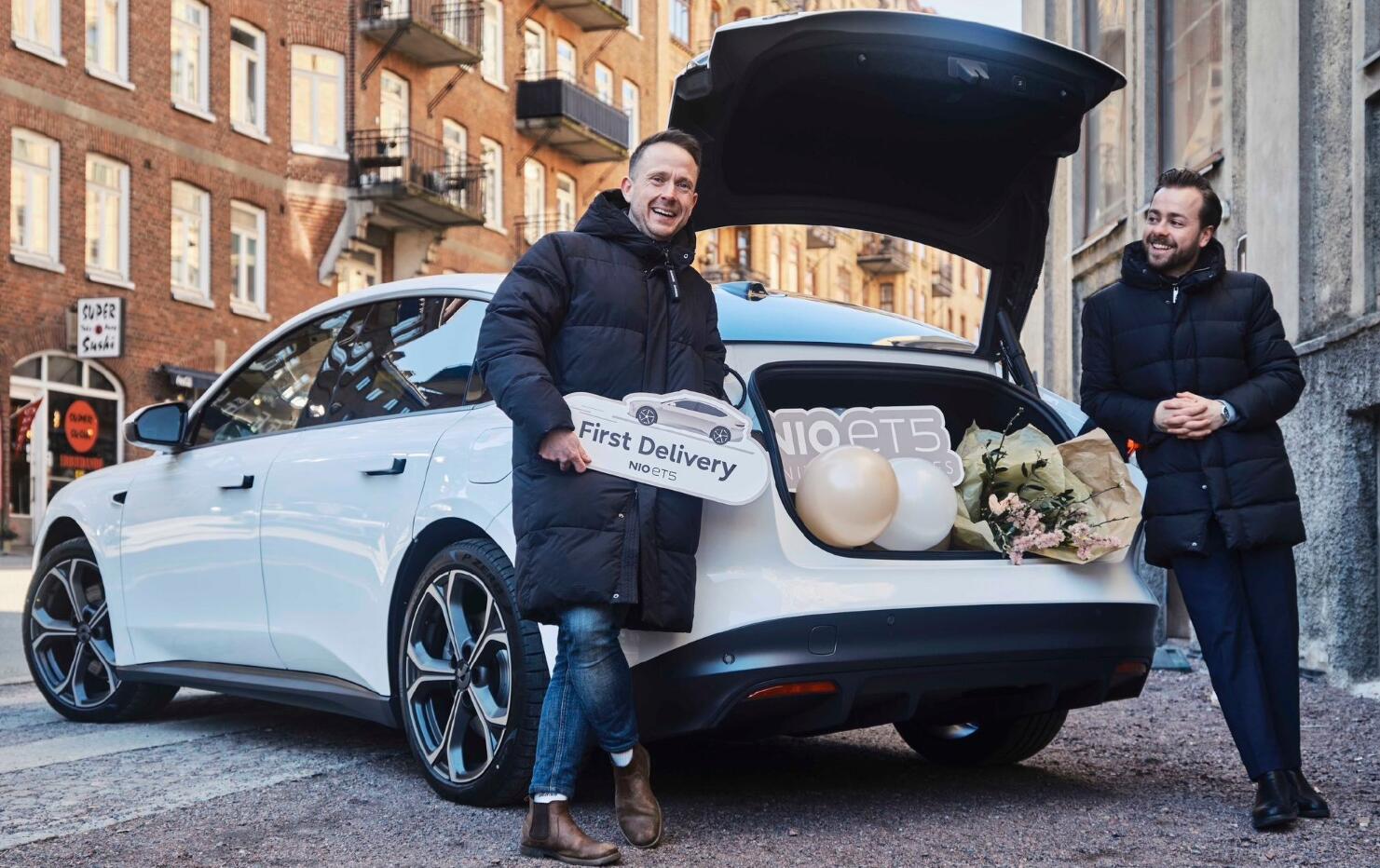
NIO launched the ET7, ET5 and the EL7, known in China as the ES7, in Europe last October. ET7 deliveries began in Europe last October, and EL7 deliveries began at the end of January.
NIO initially only allowed European consumers to lease vehicles through NIO Subscription, with purchase options available starting in late November.
These products are made available for order gradually in Norway, Germany, the Netherlands, Denmark and Sweden through the NIO Subscription, lease program and direct sales to customers, NIO said on November 1 last year while announcing delivery figures for October.
The announced delivery volume represents vehicle deliveries through direct sales to users as well as to the leasing program partner in Europe in accordance with the revenue recognition policy of the company's vehicle sales, NIO said at the time.
The vehicles under NIO Subscription in Europe are recognized as assets on the company's balance sheet, but are not counted in the announced deliveries, according to the company.
The day before deliveries of ET5s began in Europe, NIO opened a new NIO House in Frankfurt, its second in Germany.

The post NIO begins ET5 deliveries in Europe appeared first on CnEVPost.
For more articles, please visit CnEVPost.
Up to 70 percent of NIO's owners are in China's tier 1 and tier 2 cities, and the company wants to leverage battery swap stations to reach out to less-developed tier 3 and tier 4 cities.

(Image credit: CnEVPost)
NIO (NYSE: NIO) announced aggressive new battery swap station construction plans late last month. Now, one of the company's co-founders has revealed more about the thinking behind it.
Up to 70 percent of NIO owners are in China's first- and second-tier cities, and for the less-developed third- and fourth-tier cities, the company wants to reach out with battery swap stations rather than showrooms that include NIO Houses and NIO Spaces, said its co-founder and president Qin Lihong.
Qin mentioned these in an interview with local media 36kr, saying, NIO had opened stores in third and fourth-tier cities, but found the results to be mediocre, according to the text of the interview released today.
That's because even if NIO opened stores in those cities, it still took some time for the people there to accept new things, so the company has now adjusted its strategy, Qin said.
Battery swap stations in tier 3 and tier 4 cities can replace stores, Qin said, adding that there is some market space in those cities, but the traffic is not steady, so stores are not needed.
But with battery swap stations, people will be able to see these facilities every day, he said.
In addition, some cities may not contribute many sales, but are travel destinations for residents of big cities, such as Chongming in Shanghai, he said.
NIO's plan, announced at NIO Day late last year, was to add 400 battery swap stations in 2023.
On February 21, that plan was revised upward to 1,000, and NIO founder, chairman and CEO William Li said at the time that the company would also increase its efforts to build the facility in third- and fourth-tier cities and counties that have certain user base and do not yet have battery swap stations.
At an internal NIO meeting late last year, several executives were asked to vote on the business that would best drive sales in 2023, and battery swap stations received the most support, according to the 36kr report today.
The addition of 1,000 battery swap stations this year represents more of a commitment for NIO, meaning the company will build as many of the facilities as it can, according to Qin.
In the interview, Qin also refuted claims that NIO doesn't care about costs, saying the company is very clear about its numbers.
In addition to the normal advertising, public relations and maintenance costs, there are several special metrics in NIO's marketing costs, including the average cost of user development and the average cost of user service, he said.
NIO's average development cost per user is the cost of everything about selling cars, which the company aims to optimize year by year. But such costs do not have a particularly large scale effect, such as advertising costs, which are not cheaper the higher the investment, he said.
NIO's average cost of user service, including car repair, maintenance, charging, battery swap, they are decreasing year by year, Qin said.
Qin did not disclose specific numbers but said NIO's average cost of user service this year could be a quarter of what it was in 2018.
The post NIO aims for swap stations to serve partly as showrooms in underdeveloped cities appeared first on CnEVPost.
For more articles, please visit CnEVPost.
NIO and Li Auto's mobile apps have been featuring pretty girls significantly more often lately, while XPeng is running a campaign to encourage users to share such content on its app.

Whenever we open the NIO (NYSE: NIO) mobile app to see what's going on at the company, there are always posts with lots of pictures of pretty girls on the front page.
This practice has been seen occasionally before, but has become more frequent this year with the large deliveries of the ET5 sedan.
We found a similar practice after taking a deeper look at the mobile apps of Li Auto (NASDAQ: LI) and XPeng (NYSE: XPEV), with the latter launching a campaign to encourage ladies to make similar posts.
The NIO App is a great source for monitoring information about NIO and a great way for many people to learn about the company's developments and vehicle models.
The app has probably the largest number of users of any Chinese carmaker, and may even surpass many popular apps from local tech giants.
As of December 12, 2022, the NIO App had accumulated more than 5 million registered users, Qin Lihong, the company's co-founder and president, said in a media communication late last year.
Qin said at the time that NIO App had more than 380,000 daily active users and could reach more than 400,000 at its peak.
"Now many people treat NIO App as a vertical media, and a popular one. Not only the content shared by NIO users, but I believe you can also get a lot of industry information, including the latest news, from our app," Qin said.
Before this year, pretty girls didn't appear in the NIO App very often, perhaps because the company had previously been delivering models with high prices and targeted mainly a relatively affluent demographic.
With the mass delivery of the ET5, which targets a younger demographic, pretty girls are appearing significantly more often in the NIO App.
In January-February, NIO delivered 20,663 vehicles, of which the ET5 contributed 12,266, or 59 percent, according to data monitored by CnEVPost.
More than half of NIO owners are ladies, and 83.9 percent have a bachelor's degree, according to a report released last month by local market research firm Sino Monitor.
The Li Auto App shows a similar picture, especially as deliveries of the new SUV Li L7 begin.
Li Auto targets family users, and the Li L9 and Li L8 are both six-seat models. The large space and well-considered details make them a must-consider option for many families with children when purchasing a car.
Before this year, the Li Auto App showcased posts shared from users that essentially described how the vehicles had worked for their families.
But as deliveries of the company's first five-seat SUV, the Li L7, begin this month, there are more posts with photos of pretty girls, although the company is still emphasizing that the SUV is still aimed at families.
There are relatively fewer posts with photos of pretty girls in XPeng's mobile app, but that doesn't mean the company doesn't want to recommend such content.
Earlier this month, the company posted a thread on the XPeng App calling on female car owners to share their experiences with their cars, and prizes will be awarded for the best content.
The campaign runs from March 2 to March 31, and XPeng will announce which ones have won rewards on April 5.
Understandably, NIO, Li Auto and XPeng are doing this. After all, articles with pictures of pretty girls are more likely to attract readers to click on them, thus increasing people's understanding of their products.
NIO and Li Auto have done better in this regard, in large part perhaps because their helmsmen were previously the founders of two of China's largest automotive media outlets.
Li Xiang, the founder, chairman and CEO of Li Auto, is the founder of Auto Home, and William Li, the founder, chairman and CEO of NIO, is the founder of Yiche. The websites of these two auto media outlets attract tens of millions of users every day, and posts with pictures of pretty girls are common.
Here are screenshots of some of the content recommended on the NIO App homepage.







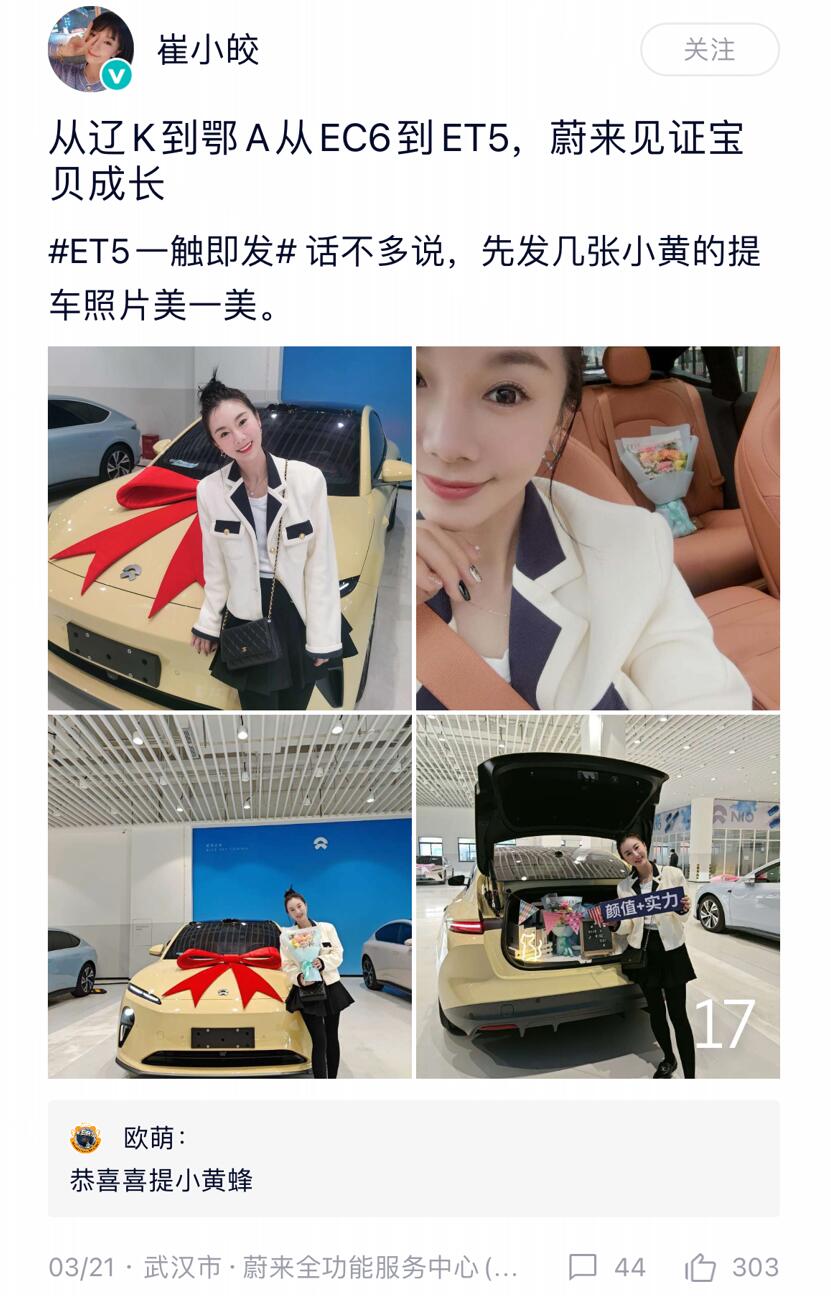

Here are screenshots of some of the content recommended on the Li Auto App homepage.







Below are screenshots of some of the content from the XPeng App.

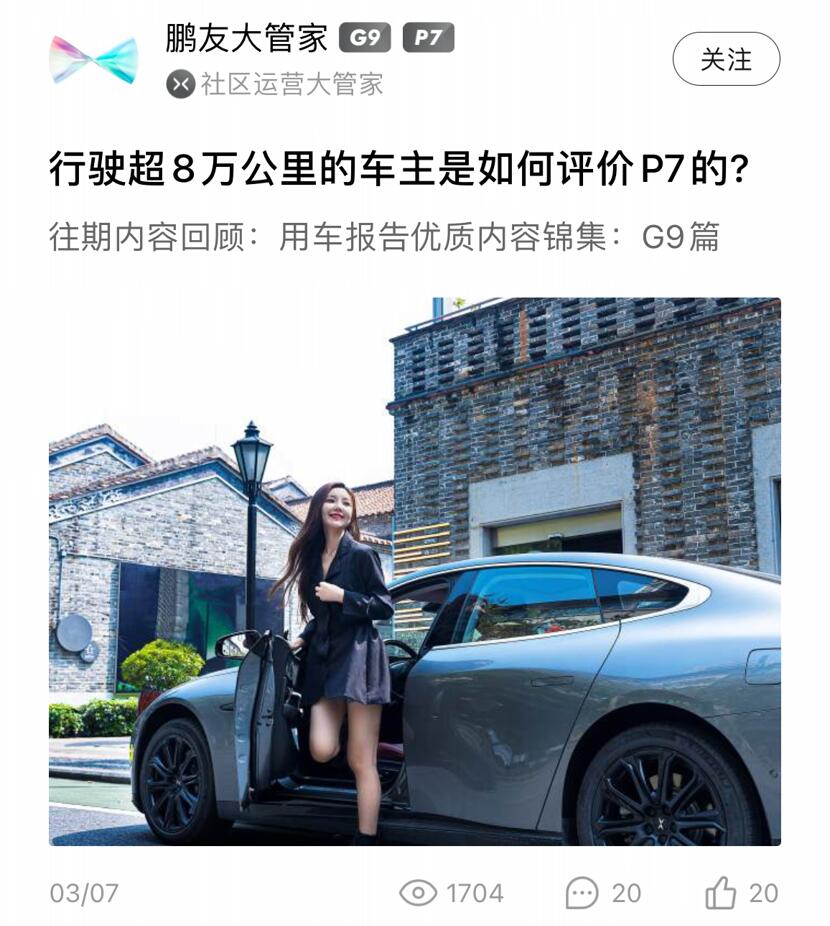




The post The common feature of NIO, Li Auto, XPeng's mobile apps? Pretty girls! appeared first on CnEVPost.
For more articles, please visit CnEVPost.